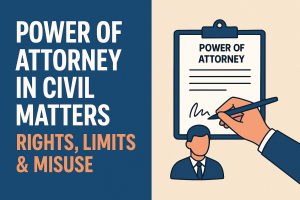Introduction
Revenue administration forms the bedrock of land governance in India, where the state has an overarching responsibility to manage public lands, regulate ownership rights, and collect land revenue. In Gujarat, revenue administration is governed primarily by the Gujarat Land Revenue Code, 1879, supplemented by various land and tenancy legislations such as the Bombay Tenancy and Agricultural Lands Act, 1948, and the Right to Fair Compensation and Transparency in Land Acquisition, Rehabilitation and Resettlement Act, 2013. This blog provides a comprehensive overview of the key authorities involved in revenue matters: Mamlatdar, Collector, and other Revenue Officers, outlining their roles, powers, and legal mandates.
1. Mamlatdar: The Taluka-Level Revenue Authority
Legal Basis:
Gujarat Land Revenue Code, 1879 (Sections 5 to 8)
Bombay Tenancy and Agricultural Lands Act, 1948 (Section 70)
Appointment & Jurisdiction:
The Mamlatdar is a class II gazetted officer appointed by the State Government and is responsible for a specific taluka (sub-division of a district). As per Section 6 of the Gujarat Land Revenue Code, the Mamlatdar exercises powers as a revenue officer, a quasi-judicial authority, and a general administrative officer.
Core Functions:
Maintaining land revenue records and supervising the Talatis
Conducting inquiries and passing orders on mutation entries (Form VI)
Partition of holdings under the revenue records
Removal of encroachments on government and public land
Issuing certificates such as income, caste, domicile, and solvency
Jurisdiction over tenancy disputes under Section 70 of the BTAL Act
Implementing schemes related to crop insurance, relief, and disaster compensation
Quasi-Judicial Powers:
The Mamlatdar is empowered to summon parties, examine witnesses, and conduct hearings akin to a civil court under the Code of Civil Procedure, 1908.
2. Collector: The Apex District-Level Revenue Officer
Legal Basis:
Gujarat Land Revenue Code, 1879 (Section 6, 203)
Right to Fair Compensation and Transparency in Land Acquisition Act, 2013
Gujarat Tenancy and Agricultural Lands Act, 1948
Appointment & Scope:
The Collector is the chief revenue authority in a district and is appointed under Section 6 of the Gujarat Land Revenue Code. The Collector supervises the entire revenue administration within the district, including the work of Deputy Collectors, Prant Officers, and Mamlatdars.
Key Functions:
Supervisory authority for all revenue officers in the district
Hearing appeals and revisions against the orders of subordinate officers (Section 203)
Conducting land acquisition proceedings under the Land Acquisition Act
Managing allotment and grant of government land to various beneficiaries
Ordering eviction of encroachments and recovery of arrears as land revenue
Conducting inquiries into boundary disputes and settlement operations
Coordinating revenue functions with development and disaster management tasks
Quasi-Judicial and Administrative Powers:
The Collector exercises appellate and revisional jurisdiction, and his decisions are binding unless reversed by the Commissioner or High Court. Collectors also have magisterial powers in case of public order or urgent land disputes.
3. Other Revenue Officers: A Coordinated Administrative Chain
Hierarchy and Roles:
The term “Revenue Officers” includes a wide array of functionaries from the village to the district level. Their appointment and powers are governed by Section 6 and related provisions of the Gujarat Land Revenue Code.
Deputy Collector
Handles appeals against Mamlatdar orders, manages sub-division level revenue affairs, land acquisition, and tenancy issues
Prant Officer
Acts as a supervisory authority over Mamlatdars and Talatis; handles revisions and critical revenue inquiries
Talati cum Mantri
Maintains village-level land records including 7/12 extracts, registers of mutation, and crop pattern records
Duties of Talati cum Mantri:
Entry of mutation changes in land ownership (Form VI)
Issuing certified copies of revenue documents
Assisting Mamlatdar in surveys and field inquiries
Maintenance of Village Form No. 6, 7/12, and 8A
Circle Inspector
Supervises the Talatis under his jurisdiction; checks mutation and field inspections
Supervisory Role:
Each officer functions within a structured hierarchy and is subject to administrative and judicial review by superiors. Appeals against their decisions lie with higher revenue authorities.
Conclusion
Understanding the structure and functions of revenue authorities is critical for any individual or entity dealing with land, tenancy, or agricultural property in Gujarat. From simple mutations to complex land acquisition and tenancy cases, the Mamlatdar, Collector, and Revenue Officers play vital roles in the adjudication and administration of justice under revenue laws.
At Narendra Madhu Associates, we provide legal consultation, representation, and compliance assistance in all revenue matters, ensuring your rights are protected and your interests well-represented.
Contact us today for expert legal support in revenue and land-related matters.



